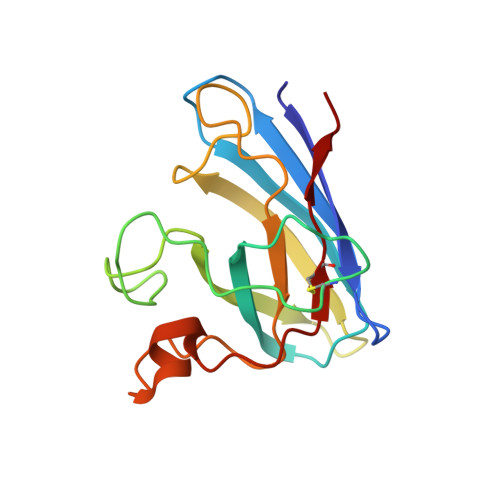The solution structure of a monomeric, reduced form of human copper,zinc superoxide dismutase bearing the same charge as the native protein.
Banci, L., Bertini, I., Del Conte, R., Fadin, R., Mangani, S., Viezzoli, M.S.(1999) J Biol Inorg Chem 4: 795-803
- PubMed: 10631612
- DOI: https://doi.org/10.1007/s007750050353
- Primary Citation of Related Structures:
1DSW - PubMed Abstract:
The solution structure of a mutated (Phe50Glu, Gly51Glu, Val148Lys, Ile151Lys), reduced, monomeric form of human copper,zinc superoxide dismutase (SOD; 153 amino acids) has been determined through 2237 meaningful nuclear Overhauser enhancements, out of 2492, and 43 dihedral angle constraints. A characteristic of this mutant is that of having the same overall charge as the dimeric protein, but an activity of only 20% with respect to wild-type SOD. This protein, at variance with a previously characterized monomeric form (Phe50Glu, Gly51Glu, Glu133Gln), does not contain mutations in the active site. Therefore, its characterization allows us to understand the structural changes independently induced by the monomerization and by the active site mutation. The family of 36 conformers, which have a target function with respect to the experimental constraints lower than 1.5 A2, has RMSD values with respect to the average structure of 0.94 +/- 0.14 A2 and 1.50 +/- 0.14 A2 for the backbone and the heavy atoms, respectively. The overall folding, which includes the classical eight-stranded Greek-key beta-barrel and a short alpha-helix, is very close to that of the previously characterized monomeric mutant E133QM2SOD and to that of wild-type SOD. The region involved in the subunit-subunit interactions in the dimeric protein is confirmed to be disordered in the monomeric species. It is also observed that a sizable rearrangement of the charged groups of the electrostatic loop and of Arg143 takes place in the monomeric species. The width of the active site channel, both at its entrance and at the bottleneck of the active site, is discussed in the light of the influence on the enzymatic activity and the latter with respect to the overall charge. It is also confirmed that the NH proton of His63 shields the Cu(I) from the bulk solvent, thus supporting the suggestion that superoxide may interact with the reduced metal ion in an outer-sphere fashion.
Organizational Affiliation:
Department of Chemistry, University of Florence, Sesto Fiorentino, Italy.
















